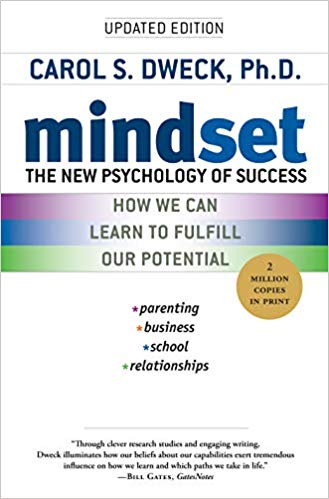

This article is an excerpt from the Shortform summary of "Mindset" by Carol Dweck. Shortform has the world's best summaries of books you should be reading.
Like this article? Sign up for a free trial here .
What business mindsets do the greatest leaders have in common? How does the right mindset help you succeed in business, and what can the most successful people teach you about adopting the right business mindset?
We’ll cover the business mindset of exceptional leaders such as Jack Welch and Lou Gerstner and explore how your personal business mindset leads to success for your entire company. This is the growth mindset for business.
Leadership and Growth Mindset for Business
The business mindset of a company’s leader is a key determinant of whether a company fails or succeeds.
One of the most spectacular business failures in recent years was the collapse of the energy giant Enron in 2006. At the heart of Enron’s failure was a fixed mindset, an obsession with talent that blinded the company’s leadership to serious problems, and blinded investors and outsiders to the fact that the business was a house of cards destined to fall.
Business gurus of the time were insisting that corporate success required hiring with a “talent mindset.” It was touted as the key to beating the competition. Enron’s culture was built on this thinking. The company recruited big talent and paid handsomely for it. But because the company celebrated talent, employees felt they had to always appear highly talented in order to survive. Basically, everyone was forced into a fixed mindset, intent on proving their superiority. This was clearly the wrong business mindset.
Since people with these fixed business mindsets can’t admit flaws, the company couldn’t acknowledge and correct its mistakes, which spelled its doom. Even after its failure, CEO Jeff Skilling never admitted there was anything wrong, instead blaming others for not getting it.
Fixed-Mindset Leaders: Self-Proclaimed Heroes
In Jim Collins’ study of great companies in his book Good to Great, he found that the average companies that he included for comparison typically had CEOs with fixed mindsets. Fixed-mindset CEOs believed they were geniuses who didn’t need a strong executive team, just underlings to implement their ideas. These CEOs needed to be the big fish and to feel superior to everyone else.
They were concerned with looking superior and enhancing their reputations. Two-thirds had huge egos that held their company back or led to its failure. They weren’t concerned with having a growth mindset for business.
Here’s a set of CEOs whose fixed mindsets caused them to sacrifice their companies for their egos.
Lee Iacocca of Chrysler
Lee Iacocca was tapped to turn Chrysler around in the 1980s. He’d been fired by Henry Ford II, which left him angry and determined to prove himself through saving Chrysler. In his first few years, he made good hires, introduced new car models, and sought bailout loans. In his autobiography, he bragged that he was a hero.
However, Chrysler soon got into trouble again, while Iacocca focused on polishing his image. He spent money on things that would boost Chrysler’s stock to impress Wall Street instead of investing in new car designs and manufacturing efficiencies. He got rid of ambitious, intelligent people he felt threatened by.
Rather than responding to Japan’s innovative new cars with better ones, he made excuses and demanded the U.S. retaliate with tariffs. He spent lavishly on a corporate suite while morale in the company plummeted. The board finally grew fed up and got rid of him.
Albert Dunlap of Scott Paper
Albert Dunlap considered himself a superstar who saved dying companies, such as Scott Paper. He compared himself to Michael Jordan and Bruce Springsteen in star power. His fixed mindset developed in childhood when his family was poor and he felt the need to prove his worth. In his career, he used shareholder profits to do that. This short-term goal was his only measure of success. He had no interest in strengthening companies for the long term, only in boosting the stock enough to sell them for a profit.
After taking over Sunbeam in 1996, he fired 6,000 people and cut most stores. But in a sense, he was too successful — stock prices rose so much that the company was too expensive to sell. So he was stuck with running it. Instead of working hard and learning, he inflated revenue numbers, fired critics, and covered up the real numbers. In less than two years, the company failed and he was ousted.
Steve Case and Jerry Levin of AOL Time Warner
What happens when two superstar CEOs with fixed mindsets combine their companies? Steve Case of AOL and Jerry Levin of Time Warner both felt superior, liked to intimidate, took others’ credit, refused to hear complaints, and fired critics. When they merged their companies, AOL was near ruin, but instead of working together to salvage it, they competed for power. Levin failed first and Case refused to work with the new CEO because he didn’t want to share power and credit — he’d rather let the company fail. When he finally was forced to resign, he denied responsibility for any problems. By the end of 2002, AOL Time Warner had lost nearly $100 billion in market value, the largest annual loss in U.S. history.
Other Characteristics of Fixed-Mindset Leaders
As noted, Iacocca, Dunlap, Lay/Skilling and Case/Levin put their personal interest in looking good above corporate interests at key points. Paradoxically, as their companies barrelled toward disaster, they felt invincible and entitled. As their companies faced real threats, they lived in an alternate reality. They didn’t have a growth mindset for business.
For instance, while getting millions in compensation, Lay took huge personal loans from the company and used corporate jets as his personal family air service. Iacocca threw Christmas parties for the company elite, at which he presented himself with an expensive gift at company expense. In their worlds, they felt validated while their companies burned. Facing and addressing the problems would have entailed risks of failure they were unwilling to take.
Fixed-minded bosses also have a penchant for abusing employees. In his book, Brutal Bosses, Harvey Hornstein says that abusing others shores up a boss’s feelings of superiority, competence, and power. Skilling denigrated others, while those who worked with Levin compared him to Caligula. A former CEO of Sunbeam-Oster, Paul Kazarian, threw things at his executives. Fixed-mindset CEOs excuse this behavior by claiming to be perfectionists or wanting to keep people on their toes. Pleasing the boss becomes the employees’ priority.
Growth-Mindset Leaders
In Good to Great, author Jim Collins examined what separated good companies from the best. He studied eleven companies over five years, whose stock had soared and who had stayed at the top of their industries for at least fifteen years. Each was compared with an average company in the same industry.
A key factor for success was that the leaders of great companies led with a growth business mindset. They shared characteristics such as:
- Being humble
- Asking questions
- Confronting failures while confident of success
- Downplaying hierarchy
- Constantly trying to improve
- Surrounding themselves with competent people
- Sharing the credit
- Rejecting power games
- Thinking of the company’s future
Alan Wurtzel, CEO of Circuit City, was an example of a growth-minded leader. He held debates in his boardroom. Rather than trying to impress his board members, he used them to learn. He constantly questioned everything in order to understand where the company needed to go. He considered himself a workhorse rather than a star. He was able to turn around a company that had been near bankruptcy.
In contrast to the fear and denial permeating companies with fixed-mindset leaders, the atmosphere in a company with a growth-oriented leader is positive and energized.
Growth-minded leaders believe in their own and others’ ability to learn and develop. Instead of using their company as a tool for self-promotion, they focus on growing the company and employees.
Here’s a look at three leaders who transformed their companies with a growth business mindset.
Jack Welch of GE
Jack Welch took over as CEO of General Electric in 1980, and in twenty years its value increased from $14 billion to $490 billion. He was one of the most admired CEOs of the era, but unlike many superstars, he was self-effacing and made a point of listening and nurturing.
He often visited factories and assembly lines to listen to front-line employees. He emphasized teamwork. In his autobiography, he noted that he disliked using “I” when speaking because most of what he’d done in his life had been accomplished in working with others. He felt others made him look better and made the work enjoyable.
At several earlier points in his career, Welch had been arrogant or overly confident, which led to mistakes that he learned from. As a young engineer at GE, he caused a chemical explosion that blew off the roof. He expected a reprimand and punishment, but instead received support and understanding. This made him realize the importance of helping good employees overcome failures.
While in the running with several other candidates for CEO, he emphasized his ability to grow. When he got the job, he set up channels for feedback, asked questions about what needed changing, and discouraged elitism. He hired for growth business mindset rather than talent and preached the importance of growth, mentoring, and teamwork over individual accomplishment.
Lou Gerstner of IBM
After turning down the job several times, Lou Gerstner took over IBM in 1993 at the request of the board of directors, who realized the company was in trouble. To create a culture that fostered growth, he created communication channels, visited company operations and met with employees, de-emphasized hierarchy, and sought everyone’s input, including outside expertise.
To boost teamwork, he eliminated people who played politics, bad-mouthed others, or self-aggrandized. Instead, he rewarded people who helped others. One problem in the company was that deals were begun but not followed through, so he focused on execution. He also focused on customers’ needs by cutting prices and integrating systems.
His long-term focus didn’t impress Wall Street, though, and stock prices remained static. He persisted and by 2002, stock value had increased by 800 percent and IBM was the industry leader in hardware, enterprise software, and custom computer chips.
Anne Mulcahy of Xerox
In 2002, when Anne Mulcahy took over as CEO, Xerox had $17 billion in debt, a terrible credit rating, and abysmal stock prices. The company was struggling to sell its copy machines and hadn’t diversified. Within three years, Mulcahy turned the company around.
She started in a personal growth business mindset with the goal of learning every part of the business. For instance, she pored over the finances to understand how each decision would affect the bottom line. She found ways to get answers when executives couldn’t tell her where things stood, and she told employees the truth—that the company wasn’t viable. She cut payroll 30 percent, but took to heart the impact on employees and worried even more about the potentially greater impact the company’s failure would have on employees and retirees.
She focused on morale and employee development and rewarded people who went above and beyond for the good of the company. With short-term changes, the environment grew more positive. But these changes also positioned the company for success in the long run.
Other Mindset-Related Issues
A drawback of a fixed business mindset in CEOs and organizations is groupthink, a term popularized in the 1970s for situations where everyone thinks alike — no one disagrees, raises issues, or criticizes. It can lead to disastrous decisions.
Groupthink can develop when:
- People put blind faith in a brilliant or charismatic leader. For example, blind faith in President John F. Kennedy led to the failed Bay of Pigs invasion of Cuba. Arthur Schlesinger wrote that Kennedy’s advisers were so smitten with him that they had total faith in his ability and luck. Had just one person opposed the plan, Schlesinger believes Kennedy would have called it off.
- People in a group are enamored with the group’s genius. Enron executives believed that because they were so smart, their ideas must be smart too. They felt infallible.
- Aside: In the fifth century B.C., Herodotus wrote that the Persians had a unique way of avoiding groupthink. When a group reached consensus while sober, they later reconsidered it while drunk.
- People are afraid to object because a fixed-mindset leader punishes dissent. For example, because Iacocca got rid of critics, people were afraid to speak up. In contrast, Hewlett-Packard co-founder David Packard once gave an employee a medal for defying him for the good of the company.
When making important decisions, it’s essential to be in a growth business mindset because it fosters full discussion of both positives and negatives, resulting in better decisions.
Managing the Praised Generation
When children who are praised for their talent and intelligence grow up and join the workforce, they can be challenging employees. They demand constant affirmation and can’t tolerate mistakes or critical feedback.
Some companies have responded by giving monthly or quarterly bonuses instead of yearly bonuses, and by providing an array of perks and morale-boosting events to make employees feel valued.
A better approach would be to maintain a growth-oriented work environment emphasizing that it’s everyone’s responsibility to learn and develop personally and to help grow the company. Managers also must teach the growth business mindset to employees — for instance, by giving rewards for taking initiative rather than having the smartest idea, for overcoming an obstacle or setback, or for applying criticism and improving.
Effective Training
Companies spend hundreds of thousands of dollars to teach managers how to coach and motivate employees, but it has little impact. The reason may be that many managers don’t believe people can change. Studies show that they look for talent first and foremost, trust their first impressions, and make little effort to develop employees. Many don’t notice when employees do improve.
In contrast, growth-oriented managers view talent as a starting point to build on. They believe in developing themselves and their employees and notice improvement. Managers can be taught this mindset. Without a belief in development, training in feedback and boosting performance accomplishes little.
A Growth-Minded Culture
A company’s business mindset has a strong effect on employee efficacy and morale. Researchers found that employees in growth cultures:
- Had a greater sense of trust and empowerment.
- Were more committed, loyal, and willing to go the extra mile for the company. In contrast, employees in fixed-minded cultures had a greater interest in leaving.
- Believed the company supported innovation and risk-taking.
- Had supervisors with a positive view of employees as collaborative, committed to improvement, and having management potential.
Grow Your Business Mindset: Tips
- Whether your workplace has a fixed or growth-minded culture, you can contribute positively. Think about how you can be less defensive and apply feedback. Look for ways to learn.
- Think about how you interact with others. As a boss, are you focused on being superior or developing your employees? How do you react when employees outshine or challenge you? Look for ways to develop yourself and your employees.
- Is your company culture susceptible to groupthink and therefore prone to bad decisions? What are some ways to promote contrary or alternative viewpoint — for instance, appointing someone to play devil’s advocate?
Your business mindset can make or break your company. Focus on a growth mindset for business.
———End of Preview———

Like what you just read? Read the rest of the world's best summary of "Mindset" at Shortform . Learn the book's critical concepts in 20 minutes or less .
Here's what you'll find in our full Mindset summary :
- The difference between a growth and a fixed mindset
- How a fixed mindset keeps you back throughout your life: education, relationships, and career
- The 7 key ways to build a growth mindset for yourself






